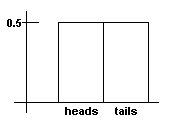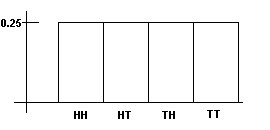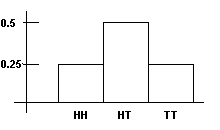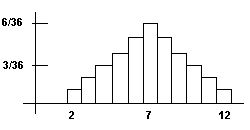Probability
Pronunciation: /ˌprɒb.əˈbɪl.ɪ.ti/ ExplainProbability is the likelihood of an event happening. Some other synonyms for probability are chance and odds. When you say, "I'll probably be at school tomorrow," you are saying it is likely you will be at school tomorrow, that there is a good chance you will be at school tomorrow.
Notation
The notation P( A ) is used to show probability. To write that the probability of rain is 50%, write P(rain) = 0.5. Notice that a decimal number is used, not a percentage.
In probability, we talk about or use:
- Event: An occurrence about which probability is measured, calculated, or estimated.
- Experiment: An experiment is doing something that makes an event occur.
- Outcome: An outcome is one way an event can occur.
- Sample space: A sample space is all of the possible outcomes.
- Probability function: A function that, when given an event, returns an estimated or actual probability of that event occurring. If one adds together the probability of all events, the sum must be 1 since this reflects all possibilities.
- Probability distribution graph: A graph that shows how the probability of events is distributed over the sample space.
Example 1: Flipping a Coin
|
When one flips a coin and records the result, one is doing an experiment in probability. The parts of the experiment are:
|
Example 2: Flipping Two Coins
|
When one flips both coins and records the result, one is doing an experiment in probability. The parts of the experiment are:
What if one does not care which coin comes up heads and which coin comes up tails? Then a tails then a heads (TH) is the same as a heads then a tails (HT). This means that there are 3 outcomes: HH, HT, TT. The parts of the experiment then are:
|
Example 3: Rolling two dice
|
Now take a look at rolling two dice. Usually one does not care which die has which value. One only cares about the sum of the dice.
|
Principles of Probability
Four basic principles of probability are:
- When quantifying, or saying the value, of a probability, we use a number between 0 and 1. In algebraic notation, for an arbitrary event A, 0 ≤ P(A) ≤ 1.
- The probability of an impossible event is 0. If event E is impossible, we write P( E ) = 0. This means that the probability of E occurring is exactly 0. In real life, very few events are absolutely impossible.
- The probability of an event that will certainly happen is 1. If event H is certain, we write P(H) = 1.
- The probability of an event not happening is 1 less the probability of that event happening. In algebraic notation for an arbitrary event A: P(!A) = 1 - P(A). For example, if there is a 30% chance of rain today we write P(rain) = 0.3. This means that the chance of rain not occurring today is P(no rain) = 1 - P(rain) = 1 - 0.3 = 0.7.
References
- McAdams, David E.. All Math Words Dictionary, probability. 2nd Classroom edition 20150108-4799968. pg 144. Life is a Story Problem LLC. January 8, 2015. Buy the book
- Grinstead, Charles M. and Snell, J. Laurie. Introduction to Probability. http://www.dartmouth.edu/~chance/teaching_aids/books_articles/probability_book/amsbook.mac.pdf. Buy the book
- Ross, Sheldon. A First Course in Probability. 6th edition. Pearson Education. 2002. Buy the book
More Information
- McAdams, David E.. Probability. lifeisastoryproblem.com. Life is a Story Problem LLC. 3/12/2009. http://www.lifeisastoryproblem.com/probability/index.html.
Cite this article as:
McAdams, David E. Probability. 4/28/2019. All Math Words Encyclopedia. Life is a Story Problem LLC. https://www.allmathwords.org/en/p/probability.html.Image Credits
- All images and manipulatives are by David McAdams unless otherwise stated. All images by David McAdams are Copyright © Life is a Story Problem LLC and are licensed under a Creative Commons Attribution-ShareAlike 4.0 International License.
Revision History
4/28/2019: Changed equations and expressions to new format. (McAdams, David E.)12/21/2018: Reviewed and corrected IPA pronunication. (McAdams, David E.)
12/1/2018: Removed broken links, updated license, implemented new markup. (McAdams, David E.)
8/7/2018: Changed vocabulary links to WORDLINK format. (McAdams, David E.)
1/12/2010: Added "References". (McAdams, David E.)
6/7/2008: Corrected spelling. (McAdams, David E.)
4/14/2008: Added probability distribution graphs. (McAdams, David E.)
4/12/2008: Simplified wording. Reorganized article. Expanded article with examples (McAdams, David E.)
3/22/2008: Revised See Also to match current specification. (McAdams, David E.)
7/12/2007: Initial version. (McAdams, David E.)
- Navigation
- Home
- Contents
-
# A B C D E F G H I J K L M N O P Q R S T U V W X Y Z - Teacher Aids
- Classroom Demos
- How To
- LIASP
- LIASP Home
- Conditions of Use
- Privacy Policy
- Donate to LIASP
- Help build this site
- About LIASP
- Contact LIASP
All Math Words Encyclopedia is a service of
Life is a Story Problem LLC.
Copyright © 2018 Life is a Story Problem LLC. All rights reserved.
This work is licensed under a Creative Commons Attribution-ShareAlike 4.0 International License







 ,
,
 ,
,
 ,
,
 ,
,
 ,
,
